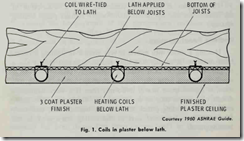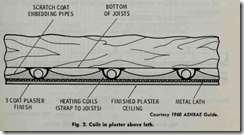Radiant heating involves the transfer of heat energy by means of waves (thermal radiation). In radiant panel heating systems, one or more interior surfaces (ceiling, walls, and/or floor) will radiate heat, thereby reducing the body heat caused by radiation. This working principle distinguishes radiant heating from conventional steam, hot water, and warm air heating systems which reduce the body heat loss caused by convection. The principles of radiant heating are described below in greater detail (see PRINCIPLES OF RADIANT HEATING).
Residential radiant heating commonly takes the form of either panel heating systems or radiant baseboard systems. The radiant baseboard systems use metal baseboard units located along the outer walls of a room. The source of the heat is hot water circulated through the baseboard units by a boiler. Additional information about radiant baseboard systems is contained in Chapter 7 Volume 1 (HOT WATER HEATING SYSTEMS) and Chapter 2 (RADIATORS, CONVECTORS AND UNIT HEATERS).
This chapter is primarily concerned with a description of radiant panel heating (or panel heating), which can be defined as a form of radiant heating in which large surfaces are used to radiate heat at relatively low temperatures.
PRINCIPLES OF RADIANT HEATING
Heat is lost from the human body through radiation, convection, and evaporation. Radiation heat loss represents the transHeating and Ventilating fer of energy by means of electromagnetic waves. The convection loss is the heat carried away by the passage of air over the skin and clothing. The evaporation loss is the heat used up in converting moisture on the surface of the skin into vapor.
Heat transfer, whether by convection or radiation, follows the same physical laws in the radiant heating system as in any other; that is, heat flows from the warmer to the cooler exposure at a rate directly proportional to the existing temperature difference.
The natural tendency of warmed air to rise makes it apparent that this induced air current movement is greater at the cooler floor and exterior walls of the average heated enclosure than at its ceiling. It is through absorption by these air currents that the radiant panel releases the convection component of its heat transfer into the room air.
The average body heat loss is approximately 400 Btu per hour and total radiation and convection account for approximately 300 to 320 Btu of it. Because this is obviously the major portion, the problem of providing comfort is principally concerned with establishing the proper balance between radiation and convection losses.
It is important to understand that bodily comfort is obtained in radiant heating by maintaining a proper balance between radiation and convection. Thus, if the air becomes cooler and accordingly the amount of heat given off from the body by convection increased, then the body can still adjust itself to a sense of comfort if the heat given off from the body by radiation is decreased. The amount given off from the body by radiation can be decreased by raising the temperature of the surrounding surfaces such as the walls, floor and ceiling. For comfort, the body demands that if the amount of heat given off by convection increases, the heat given off by radiation must decrease and vice versa.
The principles involved in radiant heating exist in such commonplace sources of heat as the open fireplace, outdoor campfires, electric spot heaters, and similar devices. In each of these examples, no attempt is made to heat the air or enclosing surfaces surrounding the individual. In fact, the temperature of the air and surrounding surfaces may be very low, but the radiant heat from the fireplace or campfire will still produce a sensation of comfort (or even discomfort from excess heat) to those persons within range. This situation can occur even though a conventional thermometer may indicate a temperature well below freezing. Radiant heat rays do not perceptibly heat the atmosphere through which they pass. They move from warm to colder surfaces where a portion of their heat is absorbed.
TYPES OF RADIANT HEATING SYSTEMS
There are several methods of applying radiant heating in buildings. Among the most popular are:
1. Circulating hot water through pipe coils located in the ceiling, floor, and/or walls.
2. Circulating warm air through shallow ducts or passages located in the walls, under the floor or in the ceiling,
3. Using electrically heated metal plates, panels, or cables.
4. Using electrically heated wall tapestrips or portable screens.
In most radiant heating installations, an entire ceiling, floor or wall is used to radiate heat to the interior spaces. Prefabricated radiant heating panels can be purchased and installed in a structure, but it is a much more common practice to construct the heating panels during the initial construction stages. In operation, the warmed panel surfaces transfer heat to the surrounding air by convection and to all solid surfaces by radiation alone. The radiant heat ray passes through the air filled space without giving up heat to it.
This chapter is primarily concerned with a description of the installation and operation of hot water radiant panel heating systems.
Radiant Panel Heating
Heating a room with panels is very similar to lighting a room. Heat radiation is exactly like light radiation except that it has a longer wave length. If a room is lighted by means of a large number of small units distributed uniformly over the ceiling, the room is lighted more nearly uniformly than if it were lighted by means of a single unit of equal capacity. Similarly, if the entire ceiling is the heating panel, the room is heated more uniformly than if only a fractional part of the ceiling were used as the heating panel.
The surface area of a heating panel should be made as large as possible. For example, if the ceiling is being used as the heating panel, it is best to use the entire ceiling. The same is true of floor panels. Generally, only the upper portions of walls are used as heating panels because the lower portions are often blocked by furniture.
Heating panels may be located in ceilings, walls or floors. Each of these locations has different advantages and disadvantages as a heating surface.
Ceiling Panels
The advantage of a ceiling panel is that its heat emissions are not affected by drapes or furniture. As a result, the entire ceiling area can be used as a heating panel. Ceiling panels are recommended for rooms or space with 7 ft. ceilings or higher. A ceiling panel should never be installed in a room with a low ceiling (under 7 feet) because it may produce an undesirable heating effect on the head.
In multiple story construction, the use of ceihng panels appears to be more desirable from both the standpoint of physical comfort and overall economy. The designed utilization of the upward heat transmission from ceiling panels to the floor of the area immediately above will generally produce moderately tempered floors. Supplementing this with automatically controlled ceiling panels will result in a very efficient radiant heating system. Except
directly below roofs or other unheated areas, this design eliminates the need for the intermediate floor insulation sometimes used to restrict the heat transfer from a ceiling panel exclusively to the area immediately below. It must be remembered, however, that when intermediate floor insulations are omitted, the space above a heated ceiling will not be entirely independent with respect to temperature control, but will necessarily be influenced by the conditions in the space below. Typical ceiling installations are shown in Figs. 1, 2, 3 and 4.
Apartment buildings and many office and commercial structures should find the ceiling panel method of radiant heating most desirable. In offices and stores, the highly variable and changeable types of furnishings fixtures and equipment favor the construction of ceiling panels; to say nothing of the advantage of being able to make as many partition alterations as desired without affecting the efficiency of the heating system.
Floor Panels
Floor panels are usually easier to install than either ceiling or wall panels. Using floor panels is the most effective method of eliminating cold floors in slab construction. Another advantage of heating with floor panels is that much of the radiated heat is delivered to the lower portions of the walls. The principal disadvantage of using floor panels is that furniture and other objects block portions of the heat emission.
Floor panels are recommended for living or working areas constructed directly on the ground, particularly one story structures. Partial ceiling or wall treatment may be used as a supplement wherever large glass or door exposures are encountered. Typical floor installations are shown in Figs. 5 and 6.
Wall Panels
Walls are not often used for heating panels, because large sections of the wall area are often broken by windows and doors. Furthermore, the heat radiation from heating coils placed in the lower sections of a wall would probably be blocked by furniture. As a result, wall panels are generally used to supplement either ceiling or floor panels in a radiant panel heating system.
Wall panels are commonly used as supplementary heating in bathrooms, and in rooms in which there are a number of large picture windows. In the latter case, the heating coils are installed in the walls opposite the windows. Wall panels will probably not be necessary if the room has good southern exposure. Typical wall installations are shown in Figs. 7 and 8.

